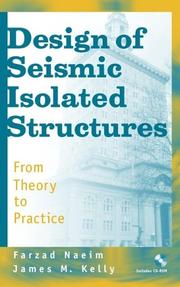| Listing 1 - 4 of 4 |
Sort by
|

ISBN: 0471149217 Year: 1999 Publisher: New York, NY : John Wiley,
Abstract | Keywords | Export | Availability | Bookmark
 Loading...
Loading...Choose an application
- Reference Manager
- EndNote
- RefWorks (Direct export to RefWorks)
Buildings. --- Earthquakes. --- Damping --- Vibrations --- Damping --- Vibrations
Book
ISBN: 3319931571 3319931563 Year: 2019 Publisher: Cham : Springer International Publishing : Imprint: Springer,
Abstract | Keywords | Export | Availability | Bookmark
 Loading...
Loading...Choose an application
- Reference Manager
- EndNote
- RefWorks (Direct export to RefWorks)
This book features chapters based on selected presentations from the International Congress on Advanced Earthquake Resistance of Structures, AERS2016, held in Samsun, Turkey, from 24 to 28 October 2016. It covers the latest advances in three widely popular research areas in Earthquake Engineering: Performance-Based Seismic Design, Seismic Isolation Systems, and Structural Health Monitoring. The book shows the vulnerability of high-rise and seismically isolated buildings to long periods of strong ground motions, and proposes new passive and semi-active structural seismic isolation systems to protect against such effects. These systems are validated through real-time hybrid tests on shaking tables. Structural health monitoring systems provide rapid assessment of structural safety after an earthquake and allow preventive measures to be taken, such as shutting down the elevators and gas lines, before damage occurs. Using the vibration data from instrumented tall buildings, the book demonstrates that large, distant earthquakes and surface waves, which are not accounted for in most attenuation equations, can cause long-duration shaking and damage in tall buildings. The overview of the current performance-based design methodologies includes discussions on the design of tall buildings and the reasons common prescriptive code provisions are not sufficient to address the requirements of tall-building design. In addition, the book explains the modelling and acceptance criteria associated with various performance-based design guidelines, and discusses issues such as selection and scaling of ground motion records, soil-foundation-structure interaction, and seismic instrumentation and peer review needs. The book is of interest to a wide range of professionals in earthquake engineering, including designers, researchers, and graduate students.
Earthquake engineering --- Vibration. --- Mechanics. --- Mechanics, Applied. --- Civil engineering. --- Geology. --- Vibration, Dynamical Systems, Control. --- Geotechnical Engineering & Applied Earth Sciences. --- Solid Mechanics. --- Civil Engineering. --- Natural Hazards. --- Cycles --- Mechanics --- Sound --- Geognosy --- Geoscience --- Earth sciences --- Natural history --- Engineering --- Public works --- Applied mechanics --- Engineering, Mechanical --- Engineering mathematics --- Classical mechanics --- Newtonian mechanics --- Physics --- Dynamics --- Quantum theory --- Dynamical systems. --- Dynamics. --- Geotechnical engineering. --- Natural disasters. --- Natural calamities --- Disasters --- Engineering, Geotechnical --- Geotechnics --- Geotechnology --- Engineering geology --- Dynamical systems --- Kinetics --- Mathematics --- Mechanics, Analytic --- Force and energy --- Statics
Book

ISBN: 9783319931579 Year: 2019 Publisher: Cham Springer International Publishing :Imprint: Springer
Abstract | Keywords | Export | Availability | Bookmark
 Loading...
Loading...Choose an application
- Reference Manager
- EndNote
- RefWorks (Direct export to RefWorks)
Classical mechanics. Field theory --- Mechanical properties of solids --- Solid state physics --- Geophysics --- Meteorology. Climatology --- Geology. Earth sciences --- Applied physical engineering --- Mining industry --- Engineering sciences. Technology --- Civil engineering. Building industry --- patroonherkenning --- aardbevingen --- toegepaste mechanica --- mijnbouw --- geologie --- ingenieurswetenschappen --- mechanica --- natuurrampen --- dynamica --- optica
Digital
ISBN: 9783319931579 Year: 2019 Publisher: Cham Springer International Publishing
Abstract | Keywords | Export | Availability | Bookmark
 Loading...
Loading...Choose an application
- Reference Manager
- EndNote
- RefWorks (Direct export to RefWorks)
This book features chapters based on selected presentations from the International Congress on Advanced Earthquake Resistance of Structures, AERS2016, held in Samsun, Turkey, from 24 to 28 October 2016. It covers the latest advances in three widely popular research areas in Earthquake Engineering: Performance-Based Seismic Design, Seismic Isolation Systems, and Structural Health Monitoring. The book shows the vulnerability of high-rise and seismically isolated buildings to long periods of strong ground motions, and proposes new passive and semi-active structural seismic isolation systems to protect against such effects. These systems are validated through real-time hybrid tests on shaking tables. Structural health monitoring systems provide rapid assessment of structural safety after an earthquake and allow preventive measures to be taken, such as shutting down the elevators and gas lines, before damage occurs. Using the vibration data from instrumented tall buildings, the book demonstrates that large, distant earthquakes and surface waves, which are not accounted for in most attenuation equations, can cause long-duration shaking and damage in tall buildings. The overview of the current performance-based design methodologies includes discussions on the design of tall buildings and the reasons common prescriptive code provisions are not sufficient to address the requirements of tall-building design. In addition, the book explains the modelling and acceptance criteria associated with various performance-based design guidelines, and discusses issues such as selection and scaling of ground motion records, soil-foundation-structure interaction, and seismic instrumentation and peer review needs. The book is of interest to a wide range of professionals in earthquake engineering, including designers, researchers, and graduate students.
Classical mechanics. Field theory --- Mechanical properties of solids --- Solid state physics --- Geophysics --- Meteorology. Climatology --- Geology. Earth sciences --- Applied physical engineering --- Mining industry --- Engineering sciences. Technology --- Civil engineering. Building industry --- patroonherkenning --- aardbevingen --- toegepaste mechanica --- mijnbouw --- geologie --- ingenieurswetenschappen --- mechanica --- natuurrampen --- dynamica --- optica
| Listing 1 - 4 of 4 |
Sort by
|

 Search
Search Feedback
Feedback About UniCat
About UniCat  Help
Help News
News